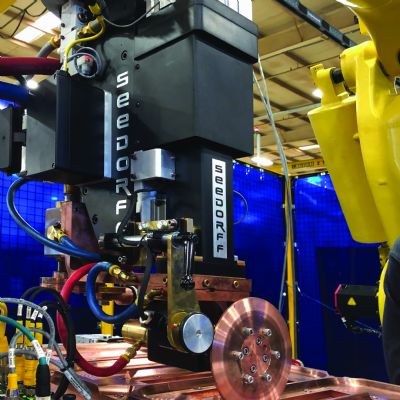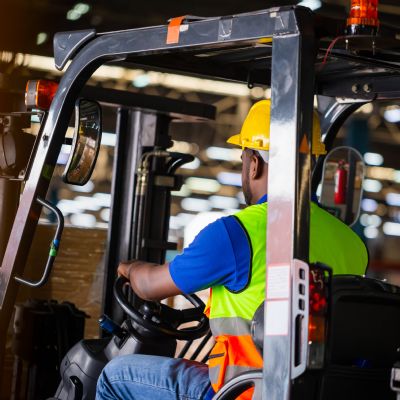“If we look back 5 or 6 yr. ago, there weren’t many data scientists in manufacturing, and when we started looking to build out the team, we had few applicants. Now when we post an opening for engineers with that type of expertise, we get hundreds of applicants, so clearly there’s been a lot of interest. Magna has undergone significant growth in this area, and we’re looking to grow the knowledge within the company, at multiple levels.”
Educating the Workforce
A key step Magna has taken, Saltsman explains, has been to educate its workforce on AI and related topics so that everyone throughout the company speaks the same language and understands the terminology. Magna wants its team members, from the shop floor to the front office, to understand the main concepts related to Industry 4.0 and digitization. It’s done so by offering online courses available through its learning-management system.
“This helps build a foundation and a common language,” Saltsman says, “so that we can discuss these topics intelligently. When we use terms such as ‘machine learning’ or ‘AI,’ which are broad concepts, everyone understands what we’re talking about.”
Saltsman and his team are tasked with developing solutions that can be scaled across the entire company, rather than those so unique that they might only work at one facility on one machine. “We work closely with our global and internal customers, and our production facilities,” he says, “to identify potential opportunities to improve efficiency, productivity and quality. We start by focusing on overall equipment effectiveness (OEE), looking at three key factors: availability, performance and quality.
OEE’s Big Three
“We understand quality very well,” Saltsman says. “Parts either meet spec or they don’t, and we already have implemented AI-powered cameras on production lines to perform visual inspection, looking at parts and distinguishing between good and bad. Where this gets really interesting is when, thanks to AI, we can detect a trend. That allows our teams to act on that trend and close the loop; the AI algorithm can recognize and analyze a specific flaw and direct upstream process adjustments to correct for it.”
Magna has several ongoing projects in this arena, where AI has proven to be very helpful, in terms of analyzing all of the parameters involved in a particular production process. “Doing so can be overwhelming for humans, or in some cases impossible,” Saltsman adds.
One area where Magna has had success is in its assembly operations, in particular the assembly of complex mechanical systems. “With AI-driven inspection, we can track the quality of parts coming down the line, and then at the end of the assembly process perform an end-of-line check,” Saltsman explains. “By feeding that data back to upstream operations, and by having previously established within the AI algorithm the process parameters that affect end-of-line performance characteristics, we’re then able to adjust those key process variables.”
 In these applications, where enormous amounts of data often are required, the use of AI can quicken the troubleshooting process. “The ultimate outcome is when the system is smart enough to close the loop on its own,” says Saltsman, “so that a human doesn’t need to make changes to the process or equipment. We’ve not yet completely closed the loop, but we are able to alert people on the line to make the necessary changes. In this way we’re empowering the people working in the production processes to do their jobs better, by giving them the necessary data and analysis.”
In these applications, where enormous amounts of data often are required, the use of AI can quicken the troubleshooting process. “The ultimate outcome is when the system is smart enough to close the loop on its own,” says Saltsman, “so that a human doesn’t need to make changes to the process or equipment. We’ve not yet completely closed the loop, but we are able to alert people on the line to make the necessary changes. In this way we’re empowering the people working in the production processes to do their jobs better, by giving them the necessary data and analysis.”
AI-Driven Condition Monitoring and PM
When it comes to analyzing and tracking machine availability on the shop floor—press lines for example—AI-driven condition monitoring and predictive maintenance can help ensure optimum machine availability and boost OEE. Magna employs this technology to look at data from a machine’s control (related, for example, to the performance of hydraulic pumps or electric motors) to identify when the process begins to deviate from normal, rather than relying on operators to periodically gather the data, or for a supervisor to study ERP-software-generated reports.
Saltsman, describing a more advanced case, hypothetically asks, “Can we actually inform the maintenance team at the plant that they have only so many hours left in production before something goes wrong, and instruct them to begin performing maintenance immediately or after so many more hours of run time? Do we need to stop the press now and work on it or can avoid production delays and wait until the shift ends, or perform the work over the weekend?”
The most complicated but perhaps most useful application of AI on the production floor: performance. “This can be challenging,” Saltsman says. “Can we run the equipment faster and reduce cycle times? To answer this, we need a detailed understanding of all of the potential effects. Does part quality suffer; do we wear out the equipment more quickly or require more frequent maintenance; will machine life be diminished?”
These complex relationships require a lot of data, far beyond the amount of data that people typically can calculate or solve. AI models most certainly represent potential tools to help facility managers make educated decisions.
“To me, this is where AI applications quickly will evolve,” Saltsman shares. “AI will be able to help manufacturers raise OEE by looking at data and parameters throughout the overall system—beyond just a press itself, for example, and include data from downstream operations such as robotic-welding cells. Because while in some cases we might already understand these relationships over a short timeframe, AI will help us see the bigger picture and the long-term effects, which requires a lot more data and modeling.”
While Magna has yet to apply such practices to stamping metal parts, it already has had success with the injection molding of plastic parts. “We can look at what happens during the molding process and understand how process variation might affect downstream operations,” Saltsman says. “When part variability impacts assembly, for example, we have to take the molding machine out of production to address the issue. With AI, we can make those adjustments in real time and optimize OEE.”
AI for Optimizing Production Scheduling
A significant task for any production manager is understanding and juggling shop-floor schedules: taking in data related to machine availability; scheduling downtime for maintenance; scheduling the workforce; scheduling projects currently in production and those on the schedule; shipping and delivery dates, and more. Optimizing this complex and critical task perhaps is most top-of-mind at Magna and for Saltsman in particular.
“We want AI to help us optimize scheduling based on customer orders that need fulfillment, as well as limitations on dunnage or warehouse space,” he explains. “We can’t carry infinite inventory. That means that we’re always in a position where we’re changing tools, and there is cost associated with each tool changeover—time, manpower and machine downtime.
“So, we’re looking at using AI to help us minimize tool changeovers while still meeting the other constraints,” Saltsman continues. “Today this is a manual data-analysis process where an experienced scheduler looks at the data and develops spreadsheets, taking several hours in most cases to develop what looks like an optimum schedule, maybe for the next few days. Conversely, the AI-powered scheduling model we’re working on will be able to crank this out in a matter of minutes and develop production plans, perhaps for several days or even weeks. The scheduler then would review the results and ensure that it makes sense.”
Among the challenges such a process faces: feeding the AI engine with live data. “We know in real time the inventory levels, the customer requirement and the status of the equipment on the shop floor,” Saltsman shares. “If we know that a press is down, for example, we don’t want to schedule work for it. Now we have to enrich the AI engine with these ‘smarts’ continuously and in real time. This is the powerful next step. We’re not there yet; we’re still feeding preprocessed data, but we have been able to use that data to generate production schedules automatically, for several days in some cases.”
Innovation at an Unprecedented Pace
By leveraging AI for tasks ranging from quality control to predictive maintenance and production scheduling, Magna has set an industry standard for enhancing efficiency, productivity and decision-making on the shop floor. While challenges remain, such as refining algorithms for subjective inspections and integrating real-time data streams, the firm’s commitment to developing scalable solutions, and to bringing its workforce along for the ride, underscores its strategic vision.
With continued innovation, AI promises to unlock considerable opportunities for manufacturers, enabling smarter processes, reduced downtime and improved OEE. MF
View Glossary of Metalforming Terms
Technologies: Management
Comments
Must be logged in to post a comment. Sign in or Create an Account
There are no comments posted. Welding and Joining
Welding and JoiningAI for Resistance Welding? Six Predictions on its Positive I...
February 19, 2025
 Management
Management3 Tools to Help Manufacturers Do More with Less
Thursday, July 10, 2025







 “AI excels at straightforward tasks,” he said, “such as confirming the presence of components in assembly processes. However, more subjective and complex applications, such as inspecting Class A surfaces, present challenges, requiring substantial training of the AI algorithm to avoid false positives and negatives. Similarly, the laser-based inspection systems currently in use still outperform AI models.”
“AI excels at straightforward tasks,” he said, “such as confirming the presence of components in assembly processes. However, more subjective and complex applications, such as inspecting Class A surfaces, present challenges, requiring substantial training of the AI algorithm to avoid false positives and negatives. Similarly, the laser-based inspection systems currently in use still outperform AI models.”